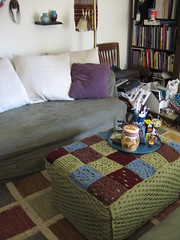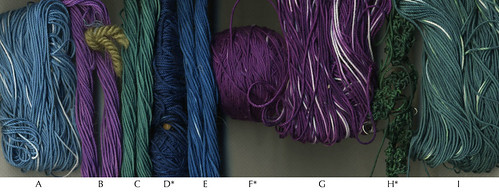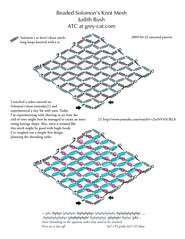I found a recipe for rice crackers that intrigued me. I knew wheat crackers could be easy to fix, but had never quite gotten around to the trying them. (I had spent time looking for the gadgets that you can use to perforate the crackers as opposed to slicing them into small squares.)
Today i’ve made i made my first and second attempts at rice crackers. I have “commercial rice flour” from the bin at Whole foods. Is this mochiko*? No idea. I’ll assume not.
To scale down, i use 1/2 c flour to 1/2 c of tap-warmed water and then added some more flour and a bit of brown sugar. It remained more like a batter than a dough. Instead of steaming it, i microwaved for 1 min on high. The resulting dough was stiff and reminded me of fimo. I kneaded it a little and then rolled it out between wax paper, placed it on a lightly greased pizza pan & flipped (greasing both sides).
With a pizza cutter, i made squares, and then i seasoned with a variety of sweet (more brown sugar, cinnamon) and savory (salt, cracked pepper, powdered onion).
I cooked it in a preheated oven at 350° for ten minutes (compare to “dry outside on mats in the sun”). The thinner ones at the edge were a bit hard and crunchy, the middle were chewy. Undercooked. One could just see where they might begin to “blister” (think of surface of saltines).
Christine put the remainders of the samples back in at 450° for roughly ten minutes. They turned golden, but were still a little tough.
The second experiment 1/2c flour to 1/2c warm water which i left in a battery state and microwaved on high for 30 seconds. The remarkable thing was the clear ring of where the microwaves heated the batter at the greatest strength: this was stiff like the earlier batter. The remainder was more like a thickened cream of wheat. I mixed this up and had a much sticker dough to which i belatedly added a bit of brown sugar.
Once it was kneaded to a smooth consistency (using more rice flour to protect against the stickiness), i started flattening, spraying with canola oil, folding, and flattening again. I’m hoping for flaky inner layers where the sheets of rice flour are fried by the inner layers of oil.
I rolled out — which was easier with this softer doug — cut and seasoned, and baked at 450° F for 16 min.
If anything, it’s the hotter oven temperature that made for the more successful trial. I’m not sure the oil needed to be incorporated. They definitely satisfy a desire for a crunch, and can be comfortably salty/savory or sweet. The thinner they are, i think the crisper, although i wonder if my small oven just bakes more hot on the outside edges.
I will probably try these again.
* Mochiko flour is also known as sweet glutinous rice flour, sweet rice flour, or mochi flour. — http://www.recipetips.com








